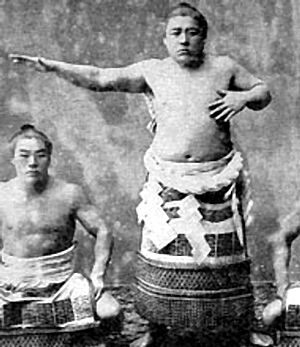Konishiki Yasokichi I facts for kids
Quick facts for kids Konishiki Yasokichi |
|
|---|---|
| 小錦 八十吉 | |

Script error: The function "getImageLegend" does not exist.
|
|
| Personal information | |
| Born | Iwai Yasokichi November 21, 1866 Musha District, Kazusa, Japan |
| Died | October 22, 1914 (aged 47) |
| Height | 1.68 m (5 ft 6 in) |
| Weight | 128 kg (282 lb) |
| Career | |
| Stable | Takasago |
| Record | 119-24-101 9draws-7holds(Makuuchi) |
| Debut | May, 1883 |
| Highest rank | Yokozuna (March 1896) |
| Retired | January, 1901 |
| Elder name | Hatachiyama |
| Championships | 7 (Makuuchi, unofficial) |
| * Up to date as of October 2007. | |
Konishiki Yasokichi I (小錦 八十吉, November 21, 1866 – October 22, 1914) was a famous Japanese professional sumo wrestler. He came from Musha District, which was in Kazusa Province. Konishiki was the 17th yokozuna in sumo history. A yokozuna is the highest rank a sumo wrestler can achieve.
Contents
Early Life and Sumo Career
Konishiki's real name was Iwai Yasokichi (岩井 八十吉). His father was a former sumo wrestler himself, named Iwajikawa. He really wanted his son to become a rikishi, which is another word for a sumo wrestler.
In 1881, a professional wrestler named Takamiyama Sogoro visited Sakura, Chiba. Konishiki's father asked Takamiyama to help his son start training at the Takasago stable. At first, Iwai found the training very tough. He even ran away home a couple of times! But his father encouraged him to go back.
In 1883, he rejoined the sumo world and took on the wrestling name Konishiki (小錦). People gave him the nickname "Kurueru shirozō," which means 'raging white elephant.' This was because he had soft, fair skin and was very good at moving quickly. He was also popular for his kind looks and warm personality. Konishiki was known for being humble, honest, and hardworking in the sumo world.
Becoming a Yokozuna
Konishiki became a yokozuna in May 1896. He received his special license from the Yoshida family, who were important in sumo. He was the first yokozuna in history to get this license while still in his 20s.
However, by the time he reached this top rank, he was already past his best wrestling years. He never won a single championship while he was a yokozuna. Some say his performance was weaker because his stablemaster, Takamiyama Sōgorō, became ill. Konishiki spent a lot of time taking care of him.
His stablemaster passed away on April 8, 1900. Konishiki then missed the next sumo tournament. He decided to retire from sumo in January 1901. During his time in the top makuuchi division, he won 119 matches and lost only 24. This means he had a very impressive winning percentage of 83.2!
Life After Sumo and Legacy
After retiring from wrestling, Konishiki stayed involved with the Japan Sumo Association. He became an elder (a sumo coach) and took on the name Hatachiyama. He even started his own sumo training center, called the Hatachiyama stable. There, he helped train other wrestlers, including Konishiki Yasokichi II.
Konishiki loved reading novels in his free time. He also kept good relationships with younger wrestlers who came after him. Famous wrestlers like yokozuna Umegatani Tōtarō I and ōzeki Araiwa Kamenosuke would visit him to listen to him read.
Konishiki passed away on October 22, 1914, when he was 47 years old. He died just before he was officially given the important name "Takasago." Because of this, he is not listed among the official Takasago elders. After his death, another wrestler, Asashio Tarō II, took over the Takasago name and became the head coach of the stable.
The name Konishiki is very special in the Takasago stable. It is often given to young wrestlers who show great promise. For example, the famous Hawaiian-born ōzeki Konishiki Yasokichi was named after him. He was actually the 6th wrestler to use the Konishiki name! In total, three wrestlers named Konishiki have reached the top makuuchi division.
Konishiki's Fighting Style
Konishiki was not the strongest physically, but he made up for it with very hard training. He was famous for his tachi-ai, which is the initial charge at the start of a sumo match. He was so fast that he would often start the match before the referee, called a gyōji, could even finish saying "hakkeyoi"!
He was very good at pushing his opponents. He was also known as a versatile fighter. This means he could use many different techniques, like striking, hanging on, throwing, and twisting his opponents. His style was a mix of fierce power and quick, agile movements.
See also
- Glossary of sumo terms
- List of past sumo wrestlers
- List of yokozuna

